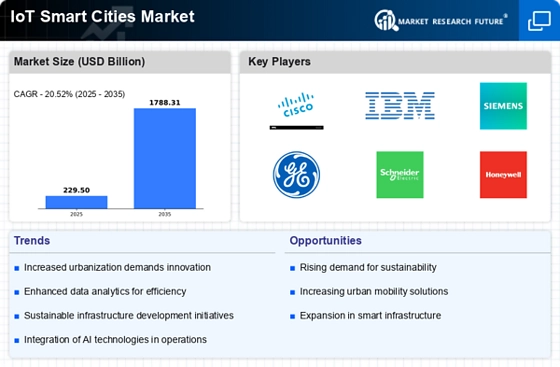Data-Driven Decision Making
The rise of big data analytics is transforming the way cities operate, significantly impacting the IoT Smart Cities Market. Data-driven decision making allows urban planners and policymakers to leverage vast amounts of data collected from various IoT devices. This data can inform strategies for resource allocation, infrastructure development, and service delivery. As cities increasingly adopt smart technologies, the demand for data analytics solutions is expected to grow, with projections indicating a market value of over 120 billion by 2025. By harnessing data effectively, cities can enhance operational efficiency and improve the quality of services provided to residents, thereby driving the growth of the IoT Smart Cities Market.
Smart Energy Management Systems
Energy management is a critical component of the IoT Smart Cities Market, as cities strive to optimize energy consumption and reduce carbon footprints. Smart energy management systems leverage IoT technologies to monitor and control energy usage in real-time. This includes smart grids, energy-efficient buildings, and renewable energy integration. Recent statistics indicate that the smart energy segment is expected to grow significantly, with investments projected to exceed 150 billion by 2025. By implementing these systems, cities can enhance energy efficiency, lower operational costs, and promote sustainability, which are essential for the future of urban living. Thus, the demand for smart energy solutions is a key driver in the IoT Smart Cities Market.
Enhanced Urban Mobility Solutions
The IoT Smart Cities Market is experiencing a surge in demand for enhanced urban mobility solutions. As urban populations continue to grow, cities are increasingly adopting IoT technologies to improve transportation systems. This includes smart traffic management, real-time public transport tracking, and integrated mobility platforms. According to recent data, the smart transportation segment is projected to reach a valuation of over 200 billion by 2026. These advancements not only aim to reduce congestion but also enhance the overall commuting experience for residents. The integration of IoT in mobility solutions is likely to foster a more efficient urban environment, thereby driving the growth of the IoT Smart Cities Market.
Environmental Monitoring and Management
Environmental sustainability is increasingly becoming a focal point for urban planners, driving the IoT Smart Cities Market towards innovative monitoring solutions. IoT technologies facilitate real-time environmental monitoring, including air quality, noise levels, and waste management. By utilizing sensors and data analytics, cities can make informed decisions to mitigate pollution and enhance the quality of life for residents. The environmental monitoring segment is projected to grow, with investments anticipated to surpass 80 billion by 2026. This focus on environmental management not only addresses regulatory compliance but also aligns with the broader goals of sustainability, making it a crucial driver in the IoT Smart Cities Market.
Public Safety and Security Enhancements
Public safety remains a paramount concern for urban areas, and the IoT Smart Cities Market is responding with innovative solutions. The integration of IoT technologies in public safety includes smart surveillance systems, emergency response management, and disaster management solutions. These technologies enable real-time monitoring and data analysis, which can significantly improve response times and resource allocation during emergencies. Recent reports suggest that investments in smart public safety solutions are expected to reach 100 billion by 2025. As cities prioritize the safety of their residents, the demand for advanced security solutions is likely to propel the growth of the IoT Smart Cities Market.


















Leave a Comment